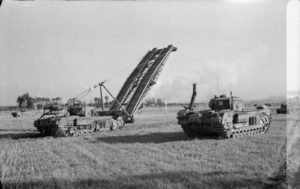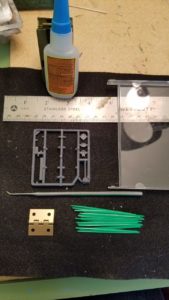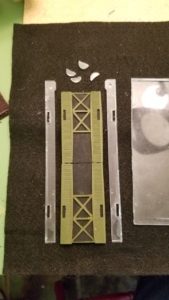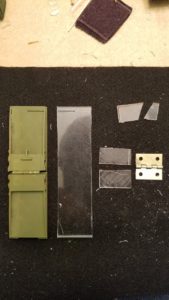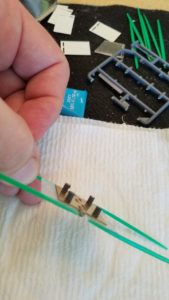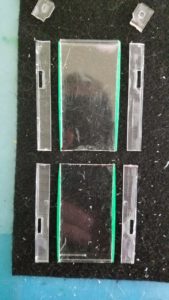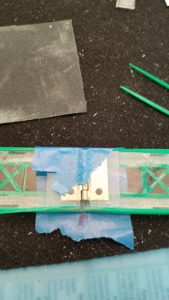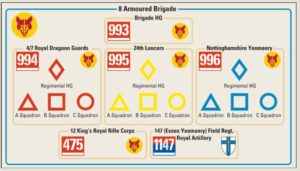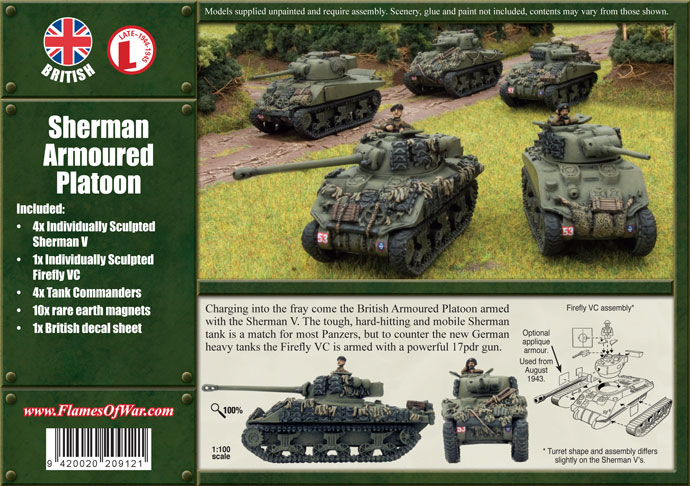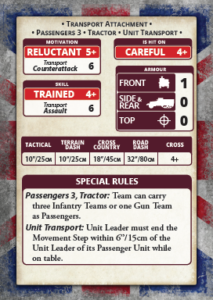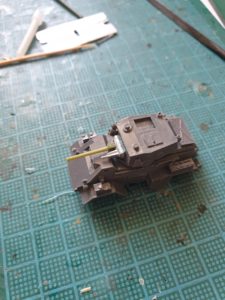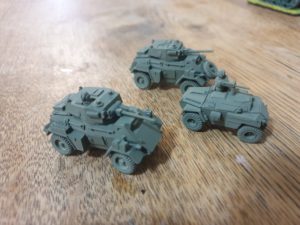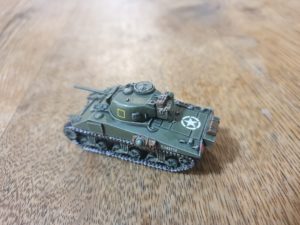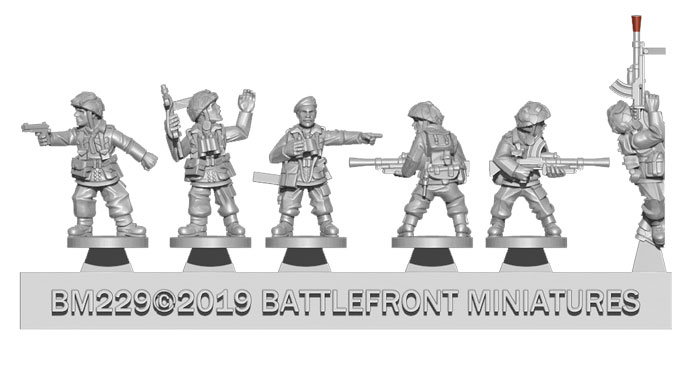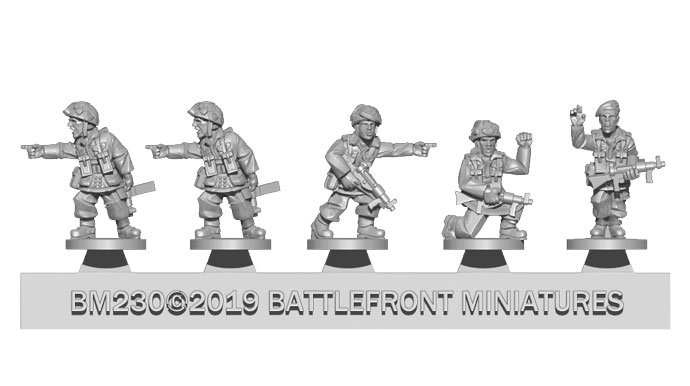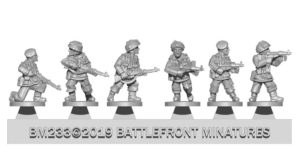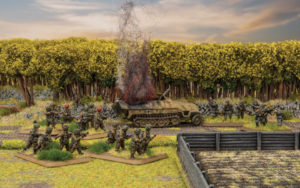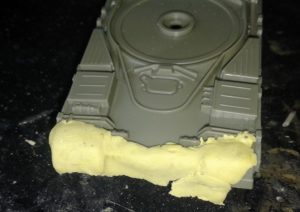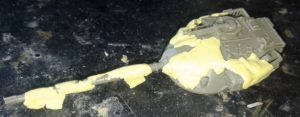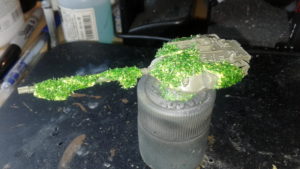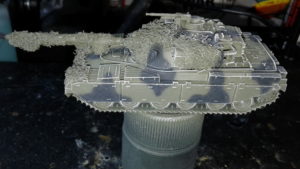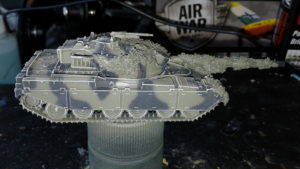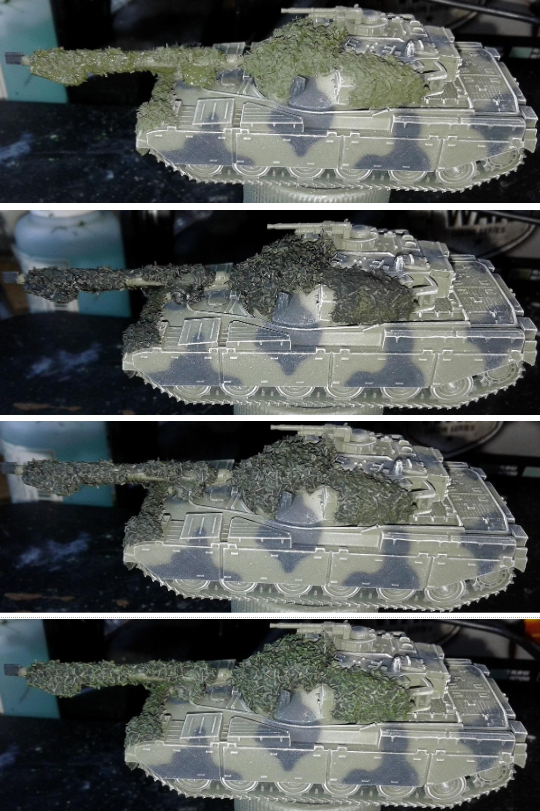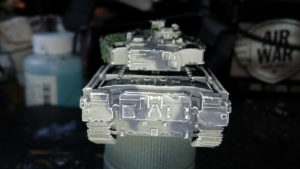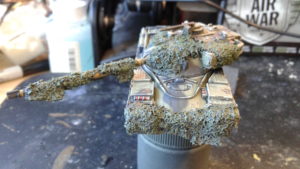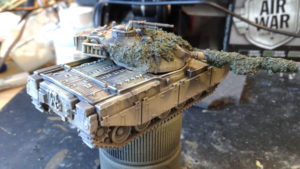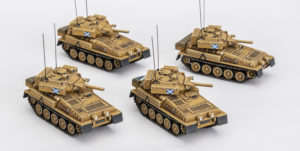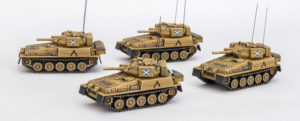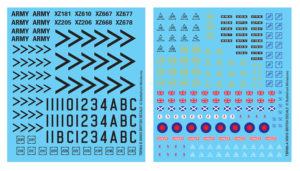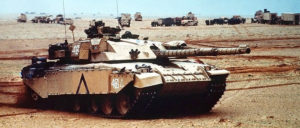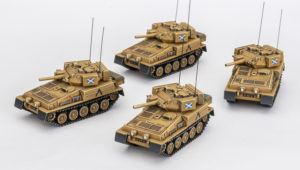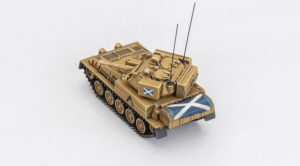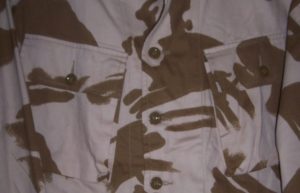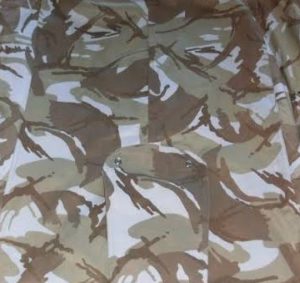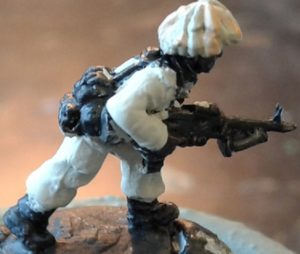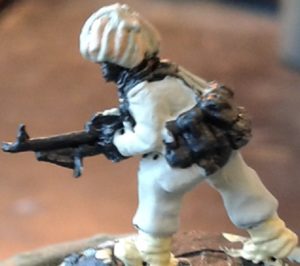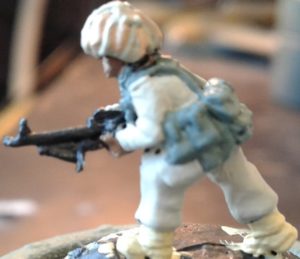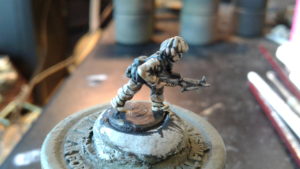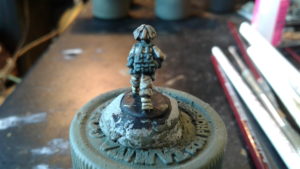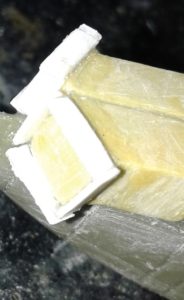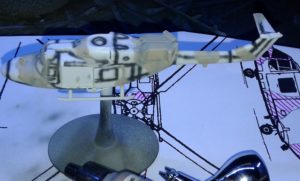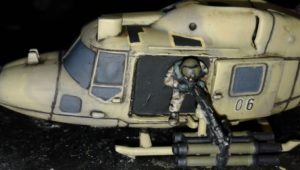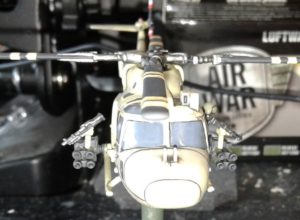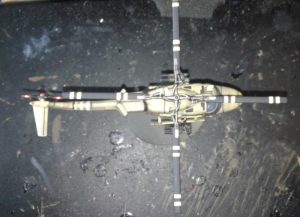Tag: Painting
Building an SBG Bridging Churchill
with Larry O’Connor
Some would say the British Small Box Girder (SBG) bridge is descended from the famous Bailey Bridge.
“I take it you mean that glorious, precision-made, British-built bridge which is the envy of the civilized world?”
That’s the one.
Hello chaps and ladies, let’s talk AVRE Small Box Girder (SBG Assault) bridges and how to make your own to help liberate Northern Europe from Jerry.
About a dozen years ago while visiting family, I found Flames Of War through a dear friend and shipmate who had an FLGS in Augusta, Georgia (Norman Schwartz at Arsenal Games – now closed.). But at the time the game really didn’t catch my fancy, I’m a Navy guy. About the same time, after a close call with cancer, my bride found an FLGS (Texas Toy Soldier (TTS) in Dallas) and she strongly encouraged me to pick up a hobby to rejoin the human race. A group of great guys at TTS play Flames Of War and I got hooked.
I chose the British Forces as virtually no one else here played them as a primary army. A few months later, the group at TTS were planning to do their annual D-Day game. I was intrigued, and being a student of WWII history for decades, I wanted to play using General Sir Hobart’s “Funnies”, particularly the AVRE and its assault bridge. I wonder often if General Sir Hobart’s funnies were used as he was General Bernard Montgomery’s brother in law. Hmm? Nevermind. Alas, I was told I would need an SBG mini. “No mini, no bridge on table”. At the time, no one here knew of a commercial source for a model so I decided to make my own. Heck, I served in two Seabee units for several years, how hard can it be? Two notes. There is a bit of fiddliness to this process and those with OCD (CDO) will either hate or love the process.
Right. So the Small Box Girder (SBG) assault bridge was a British project which in short order was copied with different tweaks by other nations. But in essence a SBG is mostly a metal bridge carried/mounted on an armored vehicle to cross obstacles – either man made or a feature of terrain, to be deployed under fire. SBGs can either be solid/fixed or fold in half. I chose to recreate the kind that fold, both for more drama (eye candy), utility (such as seawalls of different height) and it’s more dynamic.
Note, these bridges are not going to be something slapped together quickly. These are the items I use, but various substitutes should be generally available most places in hardware, hobby stores, and many are likely in your work area.
- Hobby Knife
- Safety Razor
- Some medium (hobby) sandpaper
- Tweezers
- 2-4 Clothespins (the wooden ones with springs)
- A metal ruler
- Something to cut plastic, with precision and control. I use a scribing tool but, there are other options including some power tools. A scribing tool is super sharp and when drawn with pressure against plastic it cuts a fine narrow groove by removing a thin line of plastic.
- Small metal hinges (1 per bridge) {1″ x 1″ / 2.5 x 2.5 cm}
- Plastic toothpicks (TPs)[18 per bridge]. Flat wooden ones can be substituted, but have drawbacks. My preferred are called pic-a-pic plastic toothpics. * One curious thing about these, is at certain angles they have a resemblance to girders/I-beams.
- Some small bits of plastic rod or sprue (4x 5mm long)
- polystyrene cement and/or a super glue.
- and the secret critical component, surprisingly, is the top cover of a CD case: one per bridge. You need the relatively older thicker kinds where the top cover side have grooved sides.
In many of the accompanying figures, I use a previously made SBG as a visual reference. Let us begin.
First cut the sides from the CD case cover. I cut from the inside, first removing the annoying small half-circle discs. You want to preserve the smooth outside edges of the case. These are what I will call side rails. Do not throw away the CD case yet.
Second, parallel to one side where the side was removed, cut of a full length piece of the case,1 and 5/16 inches wide (33mm). This will be the primary span. This measurement was calculated based on:
- scale to historical example
- the width of minis that would be using the bridge
- size of the hinges I chose.
Next, on the other side of the CD case lid, cut out a small 1.5″ square. (The more proper square the better, but some slight variance can be accommodated during construction.) Then cut the square in half, but it must be (or close enough) 1 4/16″ wide (31mm) – just a wee less narrow than the main span (by the width of two toothpicks). This will become a shelf below the bridge on which the hinge will be super glued. Score (scratch up) one side of these shelf pieces with sandpaper.
Shelf Hinge sub-assembly. Now score (I use an old screw driver) the sides of the hinge that fold towards themselves. Centering them, glue the small shelf pieces with the wide parts butted against the hinge but avoid getting superglue in the hinge. After the hinge has dried, glue 5mm long bits of plastic rod/sprue (to be pylons between the hinge shelf and spans) on the opposite side of the hinge, in the holes which screws would be used in normal use. Then glue toothpicks parallel to the sides. One end flush with the shelf edge.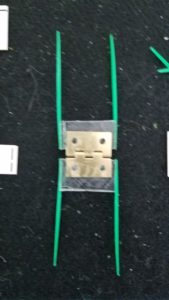
Next, let’s sort out the main spans. Mark off the ends (with the CD case hinges) with a marker- the same length as the main span. Cut off the ends of the sides of the CD case. On the bottom of the CD case/center span there may be an angled ridge which helped to keep the CD case close. I preserve that to help bridge placement during gameplay. That ridge will also help as a reference as it faces down. Measure the half way points of the side rails and main span. They should be the length of a toothpick (TP). Mark and cut them. Glue a toothpick to the outboard side on the underneath sides under the smooth edge.
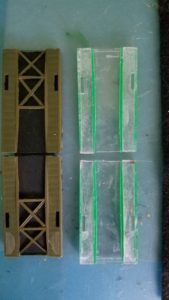
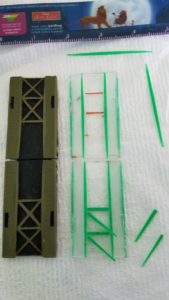
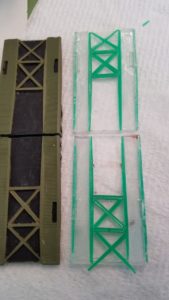
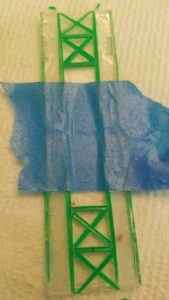
Now comes the trickiest bit of assembly.
You are going to glue/cement the 4 (styrene/sprue rods) pylons to the underneath of the main span(s). Score patches on the bottom side of the spans. Apply glue/cement to the rods, then carefully center the shelf sub-assembly so each pair of ‘pylons’ will be glued to the span pieces. I find p/s glue is more forgiving in this step while centering on the multiple X and Y axes. Hold in place with gentle pressure. After 30 seconds or so, you can gently wrap the painter’s tape around to the hinge area to hold pressure.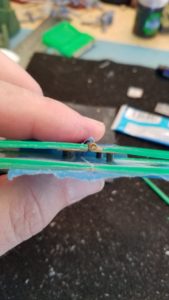
Set aside to get a good bond. (I usually let this set overnight.) When set, glue the trailing toothpicks down to the corners of the main span. Important – Rushing this step can unset the pylons.
Right. Last bit of assembly. One last toothpick per bridge side. Cut a toothpick in half. Start at one bridge half. Glue the thicker side of the toothpick to the bottom edge of the span near the hinge, gluing it down to the out side of the bottom toothpick on the hinge shelf. When dry, cut the toothpick off flush with bottom of shelf. Next take the same piece, dry fit, then snip off a tiny corner as necessary, and glue it from the top back to the shelf to make a W.
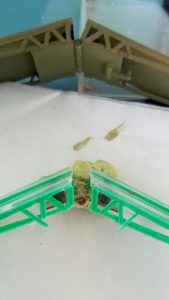
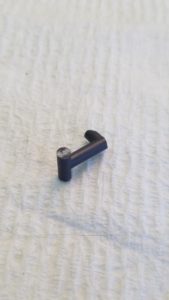
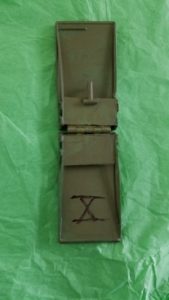
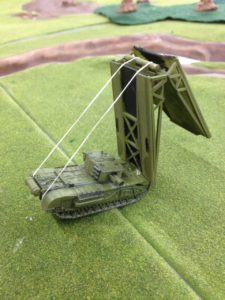
Now, it is just a matter of priming, painting and detailing your bridges. I use a rattlecan of green to prime, then base coat with whatever I use on my Brit armour – usually Russian uniform. Then I use flat black on the insert areas. A bit of a wash will enhance the ridge bits on the side rails. Now, for me, a big X to denote this is my 10th bridge I’ve made. I guarantee your mounted SBGs will be the belles of the beaches. Remember, the bridge is deployed during the shooting step after movement. Good Luck!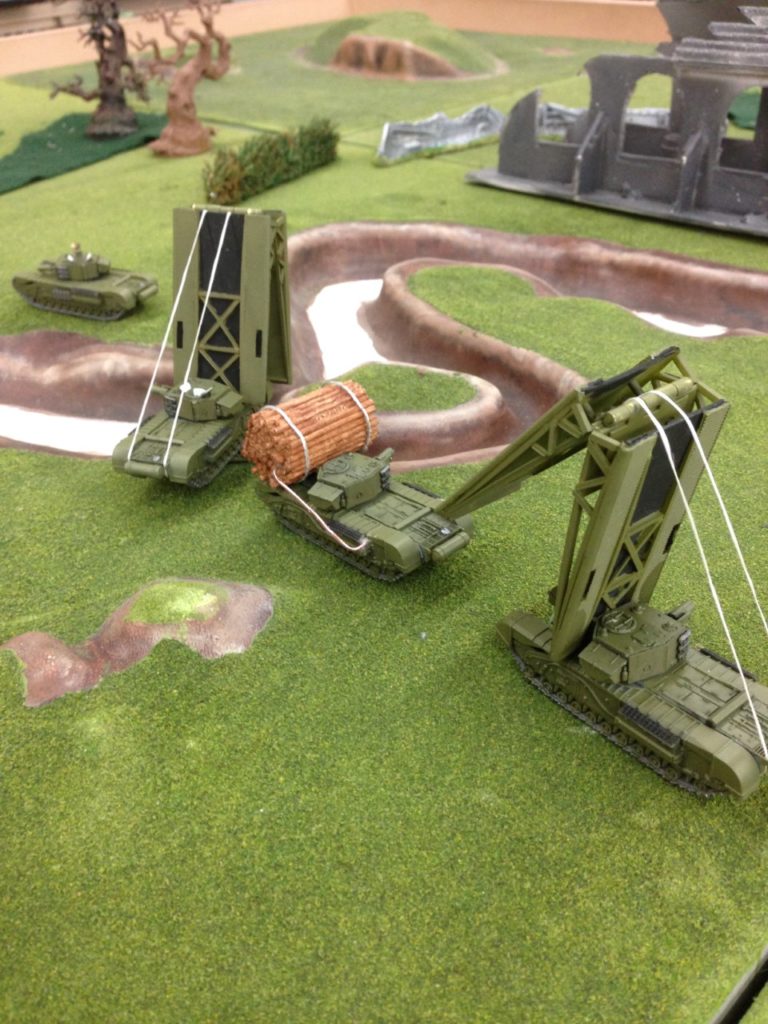
The Fox’s Mask
with Adam Brooker

Their first action came at the end of August, at the at Bir Ridge in the Battle of Alam El Hafa, against Rommels abortive attack on the right flank in the prelude to the Second Battle of El Alamein. They took part in this battle as part of the 10 th Armoured Division and in Operation Supercharge, and had at the time 24 Crusaders, 57 Grants and 37 Shermans. They also were involved in the Allied push into Tunisia and the Mareth Line in early 1943 with XXX Corps as part of the British 8th Army. The Order of Battle in October 1942 was as follows:
3rd Royal Tank Regiment
Nottinghamshire (Sherwood Rangers) Yeomanry
Staffordshire Yeomanry (Queens Own Royal Regiment)
1 st Battalion Buffs (Royal East Kent Regiment) – Infantry
1 st Regiment, Royal Horse Artillery
97th (Kent Yeomanry) Field Regiment, Royal Artillery
They fought the remainder of the Axis forces in Africa until they surrendered on the 13th May 1943. Interestingly they were involved in some of the first battles against the Tiger I, in the Battle of Wadi Akarit, around the 6th and 7th of April. They had been fighting almost constantly for almost a year and at the end of the fighting in Africa, they were one of the
most experienced Brigades in the British Army.
The Brigade then made their way back to England in December of 1943, and after a period of extended leave, they were told they were going to be involved in the Invasion of Normandy, soon after the New Year. The high level of experience that they had gained during their Africa fighting, contrasted with many of the other units that were earmarked to be involved in the Normandy Invasion, many of which, had not seen any fighting since the Battle of France in 1940.
To spread the experienced units out to the other Armoured Divisions and Brigades, two armour Regiments from the Brigade were exchanged out. The 3rd RTR was exchanged with the 24th Lancers from the 29th Armoured Brigade in the 11 th Armoured Division, and the Staffordshire Yeomanry was exchanged with the 4th / 7th Royal Dragoon Guards from the 27th Armoured Brigade, another Independent Armour Brigade. There was also a new support regiment of artillery with the new self propelled 25pdrs (Sextons) and an attached Motor Rifle Battalion of the Kings Royal Rifle Corps.
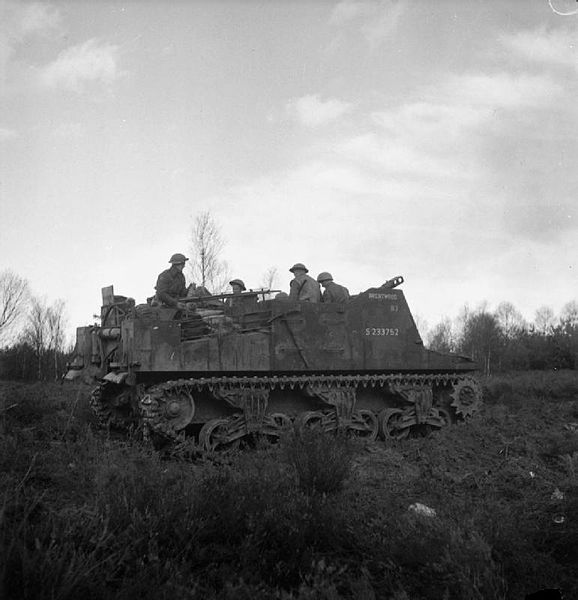
The Order of Battle for D-Day 6 June 1944 was:
4th / 7th Royal Dragoon Guards
24th Lancers
Nottinghamshire (Sherwood Rangers) Yeomanry
12th Battalion – Kings Royal Rifle Corps
147th (Essex Yeomanry) Field Regiment, Royal Artillery
They were once again under XXX Corps on D-Day and would be involved in the assault on Gold Beach, an 8km stretch of beach between the Omaha and Juno Beaches. Gold Beach was defended by elements of the 716th Static Infantry Division and the 352nd Infantry Division. The assault on Gold Beach was made the by 50th Northumbrian Division (TTs), the 56th Independent Infantry Brigade, and was to be supported by the 8th Armoured Brigade.
The 8th Armoured Brigade had worked closely with the 50th Northumbrian Division in Africa, so it made sense they would help them in the assault here. Two Regiments of the 8th Armoured Brigade had been training with special DD Sherman (Duplex Drive), amphibious tanks, with the tanks designed to lead the assault onto the beaches and to provide cover and support fire for the assaulting infantry. Unfortunately there was not enough Sherman DD tanks available in time for D-Day, for the whole Brigade, and the 24th Lancers had standard Sherman tanks issued. As such, they could not join the battle until the beaches had been secured.
The Primary Objectives on D-Day for Gold Beach was to seize the town of Bayeux, the Caen-Bayeux road, and the Port of Arromanches; the Secondary Objectives were to make contact with the Americans landing at Omaha Beach to the West and the Canadians landing at Juno Beach to the East.
The DD tanks of the Nottinghamshire Yeomanry (Sherwood Rangers) supported the assault on the Jig Green section of Gold Beach with the 231st Infantry Brigade and followed by the 56th Infantry Brigade. While on the King section of Gold Beach the 4/7 Royal Dragoons helped support the attacks of the 69th and 151st Infantry Brigades.
As the water was very rough and choppy on D-Day, the Sherman DD tanks were released only a few hundred yards out of the shore, instead of the 2 miles out as first planned. This turned out to be very lucky for both Regiments involved, as even that close to shore, tanks were lost to the rough seas. The 4/7 Royal Dragoons lost 5 tanks, and the Sherwood Rangers
lost 8. If they had been released 2 miles out to sea as planned, it is very likely most would not have made it onto the beach.
This unexpected armoured assault on the beach surprised the German defenders, as they had not expected any Allied armour on the beaches until at least 5 hours into the invasion. Throughout the day both Regiments had all three squadrons committed continuously, and all objectives were obtained by the end of the day.
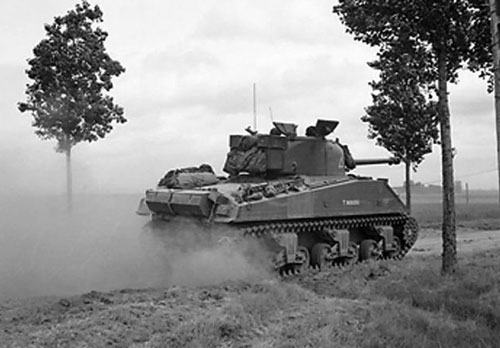
On the 7th of June (D-Day +1), the 3 rd Regiment of the Brigade landed, the 24th Lancers, as well as their other supporting units. For the next 25 days the Brigade was involved in supporting many infantry divisions (50th and 49th ), in successful assaults on German positions around Bayeux, Tilly-sur-Seulles, and Villers Bocage. But the fighting was very heavy, with
the British facing the majority of German armour in Normandy, as well as hand held anti tank weapons like the Panzerfaust, and anti tank guns like the Pak 40. Over 25 days, 146 tanks were lost or put out of action, while claiming 86 German tanks and self propelled guns knocked out over the same period.
The 8 th Armoured Brigade would continue fighting through France and into the Netherlands and Belgium and finally into Germany in 1945 until the German surrender on the 4th May 1945. Having fought from one end of Africa to the other, and then chased the Germans from France and all the way back to Germany, and were involved in almost all of the major
battles along the way.
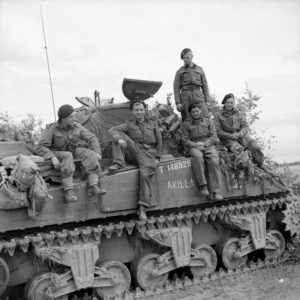
So how am I going to represent this on the tabletop? Well as this is for the British D-Day book release, I should probably start there! So it would seem picking a Formation would be the first step. As this Brigade was involved with the Landings on D-Day, picking a Sherman DD Armoured Squadron Company would seems apt. As in the early days of the D-Day battles this was exactly how this Brigade was organised, and it was not until July 1944 they moved back to standard organisation. Also, I need to be a bit different, so I chose the 24th Lancers, that is because they were a bit different too ……
The squadron had a strange unit organisation, as there was not enough available Sherman DD tanks, they had standard Sherman III and Firefly tanks, but still had the Sherman DD tank organisation. So they had as standard troops of 3 Shermans, but kept their Fireflies as a separate Troop of 3 Firefly tanks. This was different to how most other standard Sherman equipped units would operate, as they would typically attach one or even two Fireflies per troop (later in 1944) in case they ran into heavy German armour that their normal 75mm guns could not penetrate. They also had a Firefly attached to each Squadron HQ unit, so a full HQ for the 27 th Lancers would have 3 Shermans and a Firefly (12 pts + 5 pts) for 17 pts.
Also I thought I could take this opportunity to use up some old models from the metal/resin British Sherman kit (BBX08) that had the wonderful stowage and other things like track lengths modelled onto it, and to make them even more different, I was going to get special decals made up to match their historical markings. I think I’ve mentioned this before, but I really love building a force like this, as I then have to do extra research to find out what markings the Formation and support tanks have. Luckily as you can see above, in a previous article, they have done a lot of the hard work for me. So if I chose B Squadron, of the 27th Lancers they would have a yellow square, on the side of their turrets, a red and white 995, for their
arm of service flash, and the yellow and red Fox Mask for their unit symbol. Similarly it has the information for any attached Motor Platoons (475) and the Sextons (1147) that historically supported the 8 th Armoured Brigade. See below the Command Cards for using Sextons and M5 half tracks that the Motor Platoons of the Kings Royal Rifles would have used to keep up with the Shermans.
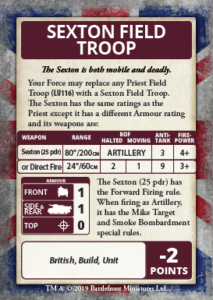
Also in another attempt to be different, I really felt that I “needed” Humber IV armoured cars, and Humber scout cars in my Force. As the Brigade did have Humber Scout cars as communication vehicles between the Scout Stuart tanks and the Squadron HQs. I mean don’t we all “need” these…… In game the Humber scout car and Dingo scout car would almost the same, stat wise, and the same for the Humber IV and the Daimler. So I converted
up some Humber IVs by using the Mid War Humber kit and cutting off the 15mm Besa MG, and adding a bit of plastic and the spare 2pdr gun barrels from the MW Valentine kit, and viola! A Humber IV armoured car! Add a Humber Scout Car, and you have a Humber Armoured Car Patrol, for 2 pts.
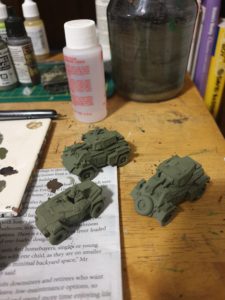
So let’s have a look at a 100 point list using this force…. I will say that the HQ is not strictly legal, but I’m sure in friendly games with reasonable opponent, if you explain what you are trying to do, most will let you re-create an historical force like this. Especially if you have gone to the effort of researching and modelling everything, just don’t expect to be able to take something like this to a tournament.
Sherman DD Armoured Squadron
Sherman DD Armoured Squadron HQ – 3 x Sherman (75mm), 1 x Firefly – 17 pts
Sherman DD Armoured Troop – 3 x Sherman (75mm) – 12 pts
Sherman DD Armoured Troop – 3 x Sherman (75mm) – 12 pts
Firefly Armoured Troop – 3 x Firefly (17 pdr) – 16 pts
Stuart Recce Armoured Troop – 3 x Stuart (37mm) – 6 pts
Crusader AA Platoon – 2 x Crusader A/A – 3 pts
Support
Humber (Daimler) Armoured Car Troop – 2 x Humber IV, 1 x Humber Scout Card – 2 pts
Humber (Daimler) Armoured Car Troop – 2 x Humber IV, 1 x Humber Scout Card – 2 pts
Sexton Field Troop – 4 x Sexton (25 pdrs) – 14 pts
Motor Platoon – 4 x Bren Gun Teams, 1 x PIAT, 1 x 2” mortar – 7 pts
Typhoon Fighter-Bomber Flight – 2 x Typhoons – 8 pts
Command Cards
M5 Half Track Transport – 1 pt
Sexton Field Troop
So from the list above, I have plenty of points in my Formation, with some versatile 75mm Shermans and also some Fireflies to take out any really tough armoured targets. Some of the lovely new plastic Stuarts to spearhead and harass light armour, and some Crusader AA tanks, to just hoon around and look cool! I am really looking forward to the new plastic Crusader AA Troop, I think it will be a blast to make and also to use on the field. I really do like self propelled AA for some reason……
We have the Motor Platoon to either quickly hold or take an objective, and two units of my new favourite Humber Scout cars to either block off/limit an opponents spearhead, and generally just harass enemy light units, and make infantry think twice about getting out of their foxholes and advancing.
I also have the Sextons, which with their 25 pdrs can be a reasonable anti tank unit in a pinch, but also give me mobile artillery and smoke options, and the cheaper cost compared to the Priest, allowed me an extra Armoured Car Troop.
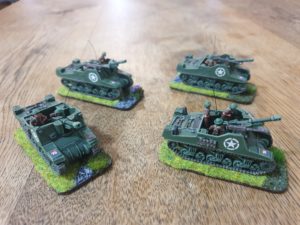
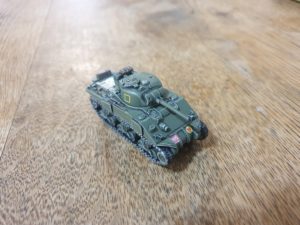
I hope to have an update for you soon with some more units painted and also some info on the other units the 8th Armoured Brigade would have had in support!
Thermoplastic 101
With the release of D-Day: British comes the first of our Thermoplastic figures, the British Airborne.
Since Thermoplastic is a relatively new technology, and as working with it is slightly different to any of our other plastic figures, it’s worth taking you through a few primers on how Thermoplastic behaves and how you can get the most out of our new figures.
The process through which the new figures are cast is similar to other casting methods for the plastics we offer- injection moulding of heated plastic. The point of difference with the new Thermoplastic technology is that the figures are cast in flexible moulds. The flexible moulds allow for undercuts, which means more detail on the figures can be cast, and that detail is much truer to the original design. Flexible moulds also allow us to broaden the number of poses we can deliver with the range of figures, meaning our infantry forces are about to get more dynamic than ever before.
None of these technical details are truly that relevant to us as modellers, but it is important to know that this casting method holds the fine detail we’ve all come to expect from Battlefront figures
Thermoplastic is a lightweight plastic with a medium amount of flex. Thermoplastic figures come on a sprue similar to the flexible plastic infantry, with eight or so figures on a single strip of Thermoplastic. Before you get started on your infantry, there are a few key differences between Thermoplastic figures and other infantry materials
Prep
As is the case with all miniature casting processes, Thermoplastic casting can occasionally leave a little flash or sometimes lines where the two halves of the mould join together. To clean these up you need to run a sharp hobby blade along the mould lines to slice them off flush with the actual figure. Filing or scraping the figure isn’t recommended and will leave a feathery residue behind. The Thermoplastic material can be cut or drilled out the same as any other infantry figure, so if you want to do head swaps or any other conversions, you will be able to as usual.
Gluing
Thermoplastic isn’t quite the same plastic as the stuff our hard plastic figures or vehicle kits are made of, and as such won’t weld with plastic cement. We recommend you use superglue to fix figures to their bases. You will also need to use super glue if you are doing any sorts of conversions on the figures themselves.
Painting
As always, it’s recommended to prime your figures before you paint them. Just like the flexible plastic figures, no paint will flake off the miniature with regular day-to-day flexing, however that doesn’t mean you shouldn’t prime the figures anyway to ensure paint adhesion. In any case, painting the new Thermoplastic figures offers no new difficulties or differences from your regular painting routine.
We are excited to get the first of our new figures out and in your hands for D-Day: British, and we are really looking forward to getting the most out of this new material as we refine and improve the process.
Aaron’s Dolled-Up Chieftain
with Aaron Te-Hira Mathie, Battlefront NZ
As the release of the new World War III British book approached Alex mentioned to me that while effective, the green and black scheme used by the British forces in Europe looked a little plain and is there a way to enhance the look … challenge accepted.
The new Challenger 1 MBT looks amazing, however I didn’t have access to one of the models at the time, so the next best thing to a Challenger is a Chieftain, so that was the model I chose to use for the purposes of this attempt to make this basic scheme look a little more of a visual feast.
The first step was to look at a few pictures of the vehicle in the field in order to get a sense of how it looks in service and anything that crews commonly did to aid in concealment while in combat (or on exercise in this case).
The first thing that is easily noted from photographic records is the preponderance of crews draping their vehicles with camouflage netting in order to break up the outline when in trying to remain undetected in prepared fighting positions peppered throughout the treelines of West Germany, so I began by adding ‘netting’ around the turret, hull front and gun tube. This was achieved by first making shapes out of Muliput modelling putty on the model, these would form the base of the ‘net’. To make this netting appear more realistic when applied you should do your best to avoid covering up optics and access points.
Once the Miliput was set, I then thinned down white glue with water and coated the putty with this mixture. I then liberally sprinkled Noch brand model railway scenery ground clutter material over the puttied areas, then tamped down the ‘net’ with further watered down white glue, then I waited for this to set. The following photo is what the end result looks like.
When the ‘net’ was dry, I gave the model an all over coat of Vallejo surface primer. This helps to fully secure the net to the model, homogenise the colour of the model before painting, as well as giving the following paint coat something to ‘bite’ into. With the undercoat dry I moved on to painting the green and black camouflage scheme on to model. I started with a basecoat of the old Team Yankee ‘Chieftain Green’ as this would allow the best comparison between this model and one that I had painted for ‘Iron Maiden’.
I then used my 0.15mm airbrush to spray on a random pattern of black shapes using Vallejo Model Air NATO Black, to form the camouflage pattern.
Then drybrushed the edges and raised details of the model with Vallejo Model Color Pale Sand, as a way of making these features more distinct.
Following the edge highlight I proceeded to paint the ‘net’ with the green side out. I started by painting it with Vallejo Model Color Camouflage Olive Green. Once this coat was dry I applied a black wash to the net in order to it some ‘depth’. When the wash dried I moved on to giving the net covered areas of the model a heavy drybrush with Camouflage Olive Green so that only the deepest recesses remained stained with the black wash. The net colour was finished off with a light drybrush of Vallejo Model Color Medium Olive on the highest parts of the net, to simulate light catching these parts of the net.
The net colour is now in pretty shape so I moved on to adding a few paint chips and scrapes over the camouflage paint. This helps to make the vehicle look a little less factory fresh. I started by identifying parts of the Tank were paint would be chipped or worn off, around track guards, hatches, corners and stowage baskets are excellent places for this treatment. I started off by painting small random shapes of Vallejo Model Color Green Grey (over green parts) and Vallejo Model Color Grey Green (over the black parts) to simulate the slightly lighter colour of the worn and chipped edges of the paint.
I then used small amounts of Vallejo Model Color German Camouflage Black Brown in the centre of the wear marks to simulate chips and scrapes that had gone all the way down to the primer paint. One of the keys to using this technique is to add the amount of paint wear that is appropriate to the subject, so in the case of this Chieftain it is supposed to be a vehicle in current service but as yet to be involved in battle, therefore some paint damage is realistic, but not too much.
Satisfied with the amount of paint wear I moved on to painting all the small details like optics, Machine Guns, fire extinguishes etc.
After painting the details I sprayed the model with an all over gloss varnish.
Once this was set and dry I used a black enamel wash, when mostly set I cleaned this up with white spirits, leaving only the most indented details black.
I then used my precision airbrush to spray on a coat of a dusty colour on the lower surfaces of the model to simulate a dust layer building up as the vehicle moves.
The final step for completing this model was to add some streaks of grime that has run down vertical and near vertical surface of the vehicle as moisture has picked up the grime. For this step I used Vallejo Environment Streaking grime.
Victor’s Gulf War Force
with Victor Pesch, Battlefront NZ
When work started on WWIII British and we were seeing early prototypes of the Challenger model, it didn’t take much convincing to decide to do a new British force.
The idea of doing a desert force appealed to me as I’ve already been painting a lot of green with black camo on my WW2 Americans, so I chose to theme the army for the Gulf War, or Operation Granby.
I came up with these forces trying to maximise Challengers, while also getting some cool new Warriors in there, and useful recon.
1x HQ Challenger ROMOR – 13 points
2x Challenger ROMOR – 26 points
2x Challenger ROMOR – 26 points
2x Challenger ROMOR – 26 points
2x Warrior (Milan) – 4 point
4x Scorpion – 4 points
Total – 99 points
A few of us in the office are planning to do some fun “big boy” games at 150 points, and that will allow me to field a more complete company of Challengers, while only having to paint three extra tanks and some aircraft.
1x Challenger ROMOR HQ – 13 points
3x Challenger ROMOR – 39 points
3x Challenger ROMOR – 39 points
3x Challenger ROMOR – 39 points
2x Warrior (Milan) – 4 point
4x Scorpion – 4 points
4x Harrier (Tornado) – 10 points
Total – 148 points
(The British were using Panavia Tornados in the Gulf, so I’ll use those models with Harrier stats)
I worked together with Casey on updating the British decals, and I was keen to get the markings for Gulf War forces in there. We’ve got the Chevrons and large numbers, as well as the little Desert Rat symbols. I also found a few pictures of tanks with Scottish flags, and that is what I’ve chosen to use on my force.
The Scorpions were the first platoon I decided to work on while we awaited the arrival of the new plastics. They’re a great little kit and are a good way to test a new scheme quickly since they’re so small.
Painting for these was pretty straight forward, and I’ve kept them clean. I can go back an add pigments/dusting later but I’ll wait and see how the Challengers turn out first.
The yellow base colour has possibly turned out a bit darker and more saturated than the real thing, but I think it’s in the ball park.
I put a large Scottish flag on the back of the platoon commander, which I will probably implement on the Challengers too.
I’m looking forward to getting the new toys as much as you all are I’m sure, and this army will be a joy to paint.
Aaron’s Oil War British: Part III
with Aaron Te-Hira Mathie
DDPM 4 Colour
Desert Disruptive Pattern Material (DDPM) comes in three flavours. The first version was introduced in 1985. This version simply replaced the four colours of the temperate/tropical DPM with browns and tans. At the time this variant was introduced there was no real requirement for the UK’s MoD to acquire very many uniforms in this colourway. It was therefore sold directly or through licensing agreements to various nations in the Middle East, including (but not restricted to) Iraq and Saudi Arabia.
‘Dense’ DDPM
The second variant was heavily used by the UK forces during operation Granby (the first Gulf War). The primary reason for this version coming into being was the realisation that British troops might be mistaken for enemy troops if deployed to the Gulf wearing the four colour Desert DPM.
A three coloured type was trialled, however it was deemed to be too close to the four colour type, so a two coloured version was rapidly developed.
This version is often described as ‘dense’ pattern as three of the four standard DPM colours were replaced with a medium brown over a tan base, causing the darker shapes to cover a large amount of the light colour.
While this was a quick expedient to get into production, an important factor as the troop build up during ‘Desert Shield’ gathered pace (therefore a pressing need for an appropriate uniform existed), it was considered too dark to be properly effective in the sun soaked sands of the Middle East.
Ironically enough a variant of this colourway was chosen for the later ‘Soldier 95 and Soldier 2000’ type desert camouflage uniforms.
‘Sparse’ DDPM
Toward to end of the first Gulf War the British stared to deploy a variant considered to be more effective in the theatre of operations. This version referred to as ‘sparse’ DDPM is quite similar to the type described above, however the pattern essentially does away with replacing the shapes of the two minor colours in temperate DPM with dark brown in favour of those shapes being the same light tan as the base colour of the uniform. This has the effect of creating a more sparse type of camouflage pattern. This variant was fairly short lived, existing only between late 1991 and the introduction of the ‘Soldier 95’ uniforms (both temperate and desert) during 1995/96.
For the figure below I chose to go for the most common variant, ‘dense DDPM’. For the purposes of our fictional conflict any of the versions would be appropriate, with the four colour type being the least anachronistic for 1985, but also far more complicated to replicate in the 15mm scale. However in a case of art imitating life I don’t consider it to be particularly far fetched for one (or both) of the two colour types to be quickly developed for exactly the same reasons that they were in the real world.
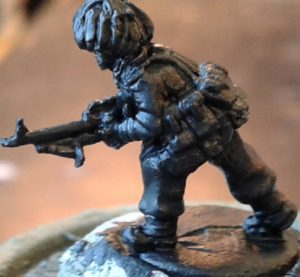
The figure is uncoated with black Vallejo Surface Primer to give the follow on paint something to ‘bite’ into.
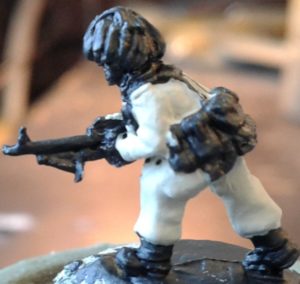
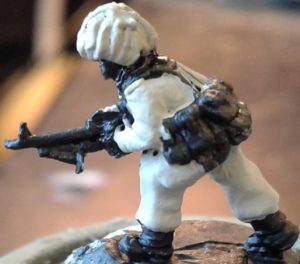
Then I paint Vallejo Model Color 70.821 (German Camo Beige WWII) as the main colour for the Hessian strips on the Helmet.
Step 4:
Following the main color of the Helmet strips I paint a random selection of the hessian strips with Vallejo Model Color 70.843 (Cork Brown).
Step 5:
Then I give the Boots a coat of Vallejo Model Color 70.976 (Buff).
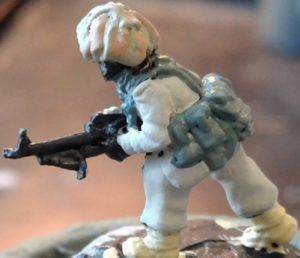
With the desert tans in place I next colour the ’58 Pattern Web Gear and Scrim netting scarf with Vallejo Model Color 70.920 (German Uniform).
Step 7:
I start with Vallejo Model Color 70.875 Beige Brown as the base colour for the flesh.
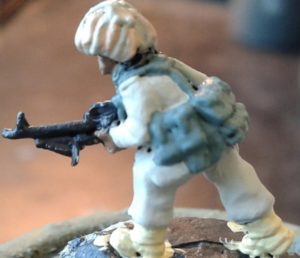
I paint the plastic furniture of the weapon with Vallejo Model Color 70.862 (Black Grey).
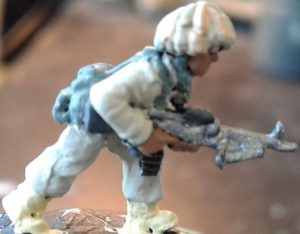
I move onto metallics, starting with Vallejo Model Color 70.863 (Gunmetal Grey) on the metal parts of the figure’s L7 GPMG.
Step 10:
I complete the initial block painting of the figure using Vallejo Model Color 70.801 (Brass) for the belt of rounds hanging off the left side of the GPMG.
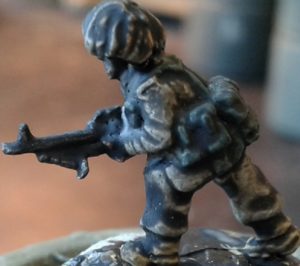
With the block painting done, I then cover the figure with an all over coat of Vallejo Game Color 73.201 (Black Wash).
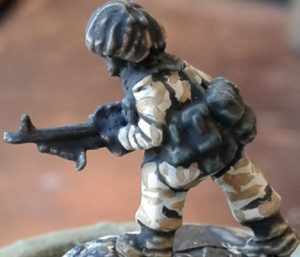
Once the Wash is dry, I go back over the uniform with Vallejo Model Color 70.884 (Stone Grey), careful to leave creases and recesses black. Then I add the DPM pattern by painting a series of swirls and stripes using Vallejo Model Color 70.873 (US Field Drab).
Step 13:
I then recolour the light Hessian strips with Vallejo Model Color 70.821 (German Camo Beige WWII), and the dark strips with 70.843 (Cork Brown).
At the same time I use Vallejo Model Color 70.976 (Buff) on the Boots, careful to leave the recesses black in all cases, to add shadow depth to the figure.
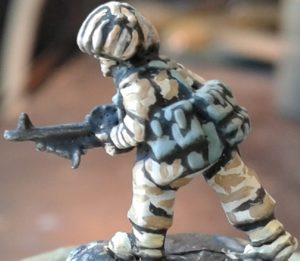
The various desert tan parts of the figure complete, I then use Vallejo Model Color 70.920 (German Uniform) to define the Web Gear and scrim scarf. I also start to define the figure’s flesh by applying a 50/50 mix of Vallejo Model Color 70.875 (Beige Brown) and 70.955 (Flat Flesh) to all but the deepest face and hand details.
Step 15: I complete the skin by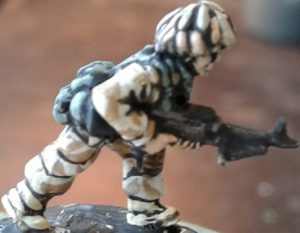
Step 16:
Before finishing the metallic colours, I go back over the GPMG’s plastic furniture with Vallejo Model Color 70.826 (Black Grey).
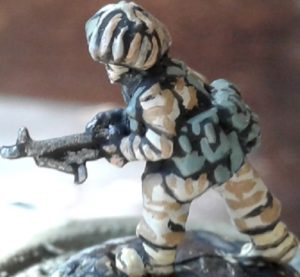
The metallics are then re-defined using Vallejo Model Color 70.863 (Gunmetal Grey) for the metal parts of the weapon and 70.801 (Brass) for the ammunition belt.
And the finished product after a coat of matte varnish:
Pete the Wargamer Paints British Desert Armour
with Pete the Wargamer
Pete sits down to give you all the steps you need to dress your WWIII: British forces for engagements in the desert, using the M109 as the test case.
Aaron’s Oil War British Part II
with Aaron Te Hira-Mathie
Oil War themed Westland Lynx AH.1
For the Lynx I was far more heavily influenced by the Lynx helicopters used by UK forces during Operation Granby.

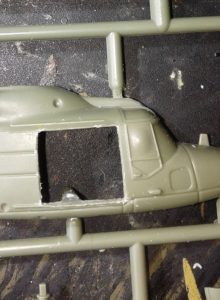
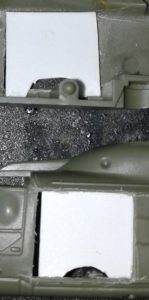
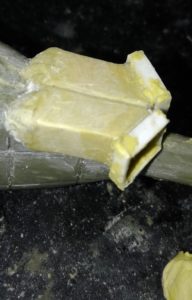
Step 3: After looking at a lot of pictures of Operation Granby era Lynx helicopters, one of the most striking additions were the squared off exhausts designed as a countermeasure to defeat heat seeking missiles. Initially I started to build these exhausts out of plastic card, however as I started to do this it was proving to be time consuming and complicated. However before giving up on the idea, I thought that I would try to make a simplified model using Miliput … with some plastic card embellishments.
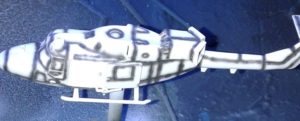
Normally I would then start with a base colour, however in this case I decided to ‘pre-shade’ the model. To do this I sprayed Vallejo Model Air 71.251 (NATO Black) along panel lines and where details meet the main part of the model. The reason to do this is add a small amount of subtle depth to the follow on paint work.
Step 5: After the pre-shade I moved on to starting the camouflage pattern. I started by spraying Vallejo Model Air 71.138 (US Sand), the darker of the two main colours in the pattern. In order to make the pre-shade work is to ensure that the paint going over it needs to be quite thin and built up in layers so that the differences in the tones of the primers shows through. How much you build up the main coat determines how heavily worn the final paint looks.
Once the tan colour was applied, I moved onto the yellow colour, in this case Vallejo model Air 71.143 (UK Light Stone). This colour was applied by building up thin layers until the desired effect was reached.
As you see the two colours are quite close to each other. This was an intentional choice as the Operation Granby aircraft were painted in the two colours that I used, therefore the camouflage scheme on the real aircraft is not particularly defined.
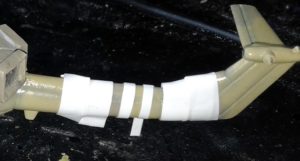

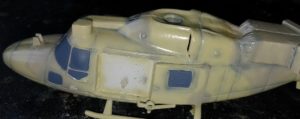

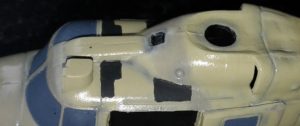
Step 9: I took this opportunity to paint some of the smaller details like the flashing light at the top of the tail, and the front grills of the exhaust system.
– Flashing light Vallejo Model Color 70.947 (Red)
– Grills Vallejo Model Color 70.865 (Oily Steel)
Then I coated the grills at the front of the exhaust box with Vallejo Game Color 73.201 (Black Wash).
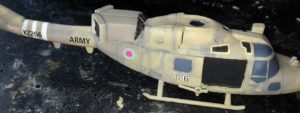

Step 10: I then applied the decals from the kit, and added a couple of decal numbers on the doors from my spares stash. Once the decals were dry, I then re-coloured the roundels to the more lightly colored ‘lo-viz’ type by
carefully hand brushing Vallejo Model Air 71.103 (Grey Blue RLM84)over the blue sections and a mixture of Vallejo Model Color 70.947 (Red) and Vallejo Model Color 70.993 (White Grey) over the
red sections of the roundels.
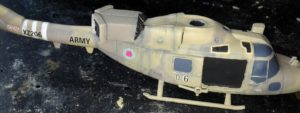


- Uniform, Vallejo Model Color 70.884 (Stone Grey), with Vallejo Model Color 70.873 (US Field Drab) DPM camouflage shapes.
- Boots, 70.880 (Khaki Grey)
- Gloves and vest, Vallejo Model Color 70.920 (German Uniform)
- Helmet, Vallejo Model Color 70.887 (US Olive Drab)
- M60D, Vallejo Model Color 70.863 (Gunmetal Grey) with a Vallejo Game Color 73.201 (Black Wash) overcoat.
Step 14: I then painted the main and tail rotors with Vallejo Model Air 71.251 (NATO Black), with Vallejo Model Color 70.916 (Sand Yellow) stripes on the main rotor, with Vallejo Model Air 71.279 (Insignia White) and Vallejo Model Color 70.947 (Red) stripes on the tail rotor. The mechanical parts of the rotor system I painted with Vallejo model Color 70.865 (Oily Steel) overcoated with Vallejo Game Color 73.201 (Black Wash).
So that’s my air support and armour sorted, all that’s left is my infantry in Desert DPMs. Coming right up…
Pete The Wargamer Paints British Armour
To celebrate the launch of WWIII: British, our buddy Pete the Wargamer has a step-by-step guide for how to paint your British armour for World War III.

